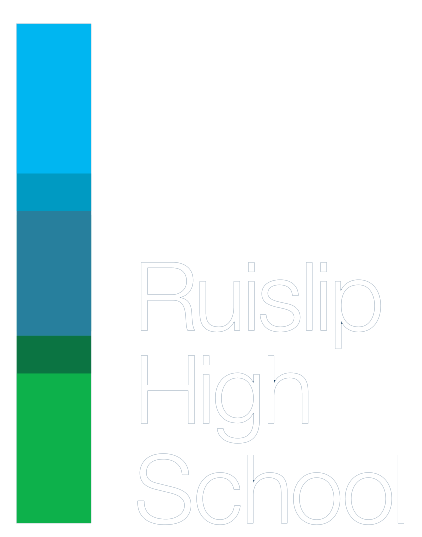Art, Craft and Design
Art and cultural production is at the centre of what makes society what it is.’ Wolfgang Tillmans
At Ruislip High School we believe that Art, Craft and Design is a subject that has an important role in the education of all students. Art, Craft and Design encourages self-expression and creativity which can build confidence and a sense of individual identity, alongside improving wellbeing. Art, Craft and Design also support our students with critical thinking and the ability to interpret the world around us. Alongside this, the arts allow students to learn skills applicable to their future jobs and creative careers. Leading people in any field are those who can think creatively and innovatively and making and participating in the arts aids the development of these skills. Furthermore, Art, Craft and Design teaches students to work both independently and collaboratively, as well as how to manage time effectively, and develops students’ determination and resilience.
We teach students to understand and appreciate the impact of creativity in the world around them, as well as giving students the opportunity to leave their creative mark in the context of the present day. This help supports students' love for learning in Art, Craft and Design and helps expand their cultural capital. We also offer after-school clubs as part of our Above & Beyond programme and engage with the local community and professional artists to give students experiences beyond the classroom.
Key Stage 3
All students study Art, Craft and Design at Key Stage 3. Students learn to appreciate and value images and artefacts across times and cultures, and to understand how art is rooted in the context of the people and our culture and society. In Art, Craft and Design, students reflect critically on their own and other people's work, judging quality, value and meaning. They learn to think and act as artists, craftspeople and designers, working creatively and intelligently through the study of historical and contemporary artists and designers.
The curriculum is sequenced to ensure students are able to improve and develop their skills over time using a variety of different media to show the breadth of what Art, Craft and Design can offer. Students study the core elements and principles of the subject and are supported in developing this skill and knowledge which is then applied to students’ own work, allowing them to create unique work they can be proud of.
Students have the opportunity to study all of the following specialisms:
Art - These lessons focus on the core fundamental elements and skills in the subject whilst studying a variety of different media, skills and themes throughout art history. By focusing on multiple different materials and outcomes, students are given the opportunity to understand the breadth and diversity of the subject alongside making social and cultural connections.
Textiles - These lessons give the students the basic skills required to construct multiple different textile pieces. Students will look at how to include functionality and also develop the decorative element of the subject. Throughout the key stage students will develop and refine their skills to allow them to create personal outcomes to demonstrate their skills and knowledge.
Graphics - These lessons provide students with the opportunity to develop not only their designing skills and compositional analysis but also to bring awareness about the advertising world around them. Students will develop their skills to create drawn and digital outcomes that focus on taking into consideration interpretation and the impact aesthetics can have on the success of their work.
Media studies (Year 9 only) - These lessons provide students with the tools required to understand the basics of media language and representation analysis through the study of the action/adventure film genre. This is then brought to life as a film poster, which encourages students to develop their photography skills and ability to use software, such as Adobe Photoshop and Affinity Photo.
Within this framework we aim to ensure that through our curriculum we:
- Create a safe and respectful learning environment that allows students to explore visual, tactile and other sensory experiences to communicate ideas through creative thinking, problem solving and expression;
- Give students the opportunity to work with a diverse range of traditional and new media, developing confidence, competence, imagination and creativity;
- Use thematic projects that guide students through the process of understanding and applying both historical and contemporary skills and explore their ideas whilst recording their experiences throughout the schemes of work;
- Challenge all students in a varied and engaged sequencing of lessons which means that students of all backgrounds can actively engage with the learning.
Key Stage 4
Information
Students can select from one of the following specialisms:
- Fine Art
- Textiles
Both of these specialisms allow students to challenge preconceived ideas and develop their own opinions and interpretations, broadening their own cultural capital and allowing them to create personal and meaningful responses. Students will be guided to make appropriate choices to create refined and developed work.
Students undertake two portfolio projects in Year 10 and Year 11. There is one externally set task in January of Year 11 culminating in a 10 hour practical exam. Both portfolio projects are graded holistically and this grade is worth 60% of the GCSE grade. The set task sketchbook and practical exam are marked holistically and are worth 40% of the GCSE grade.
Students are marked on four Assessment Objectives (AO). Each AO is marked out of 24.
The four AOs are as follows:
- AO1 Develop ideas through investigations, demonstrating critical understanding of sources.
- AO2 Refine work by exploring ideas, selecting and experimenting with appropriate media, materials, techniques and processes.
- AO3 Record ideas, observations and insights relevant to intentions as work progresses.
- AO4 Present a personal and meaningful response that realises intentions and demonstrates understanding of visual language.
Examination Board
AQA
Key Stage 5
Information
Students can select from one of the following specialisms:
- Fine Art
- Textiles
Both of these specialisms are taught as a two year course. The course allows students to be bold and brave by trying new techniques and being encouraged to push themselves out of their comfort zones to achieve even further and create their own creative voice.
The course consists of two elements:
- The personal investigation is worth 60% of the total A Level. This is a portfolio of practical work showing a personal response to either a starting point, brief, scenario or stimulus, devised and provided by the student, with a supporting essay that is 1000-3000 words.
- The externally set task is worth 40% of the total A Level. This is a portfolio of practical work showing a personal response to a given starting point culminating in a 15 hour exam.
The personal investigation comprises two discrete but linked elements. Element 1 is the practical portfolio. The portfolio will consist of a sustained project or theme and can be presented in appropriate formats. There is no restriction on the scale of work produced but students must carefully select, organise and present their work to show that they have met all four assessment objectives. Element 2 is the related context in which their chosen practical portfolio exists. This could be by exploring a theme, subject matter, movement or historical framework of the overarching starting point, course of study or theme selected. The aim of the related study is to enable students to develop their ability to communicate their knowledge and understanding of art historical movements, genres, practitioners and artworks, considering the way that these change and evolve within chronological and other frameworks.
The externally set task will be shared with the students from February 1st in Year 13. Students will have up to eight school weeks for their preparatory studies prior to their fifteen hour supervised time period. The paper will give students a choice of seven themes. Students will select one theme for which they will generate an appropriate personal response. In the preparatory period students will research, plan and develop ideas for their response to the option they have chosen.
Examination Board
AQA

